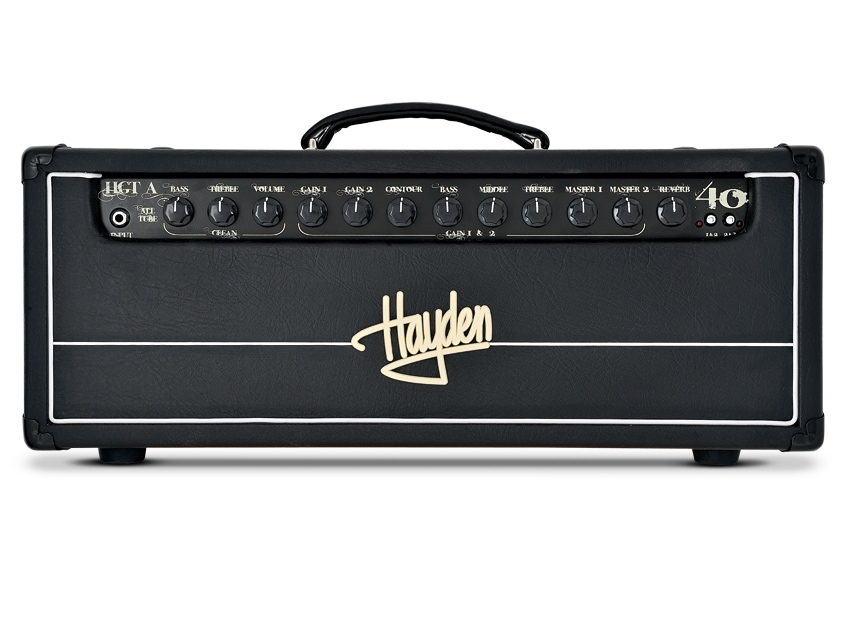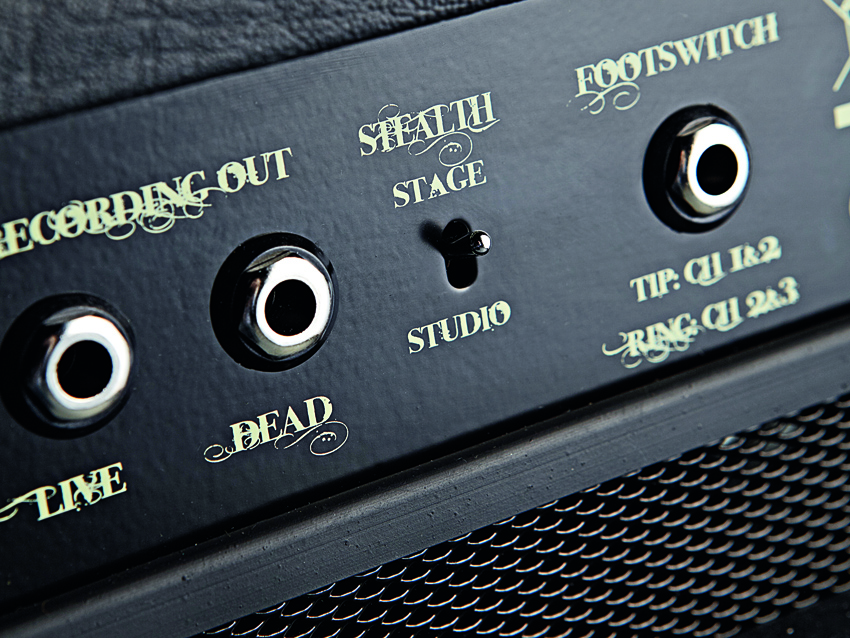MusicRadar Verdict
Reasonable value option for a giggable, valve-powered rock rig that steers away from classic Marshall and Fender.
Pros
- +
Good range of edgy rock sounds and gain levels; powerful EQ.
Cons
- -
Confusing control and channel labelling; the use of particle-board cabinetry.
MusicRadar's got your back

Hayden HGT-A40 head

Hayden HGT-A40 head
Ashdown spent time building a first-class reputation for amps - predominantly in bass, later expanded to guitar.
So when the guitar amp line was rebranded as Hayden back in 2006, a few pundits were left scratching their heads - the company was essentially starting from scratch.
"The 40-watter holds on to note definition and punch higher up the volume scale - heavy rockers will revel in the crunch and headroom of that EL34 power section in the amp."
The reasoning was that no single marque has remained fully successful in both the guitar and bass amp markets (Peavey being the exception to the rule), so after much deliberation, Hayden was born. Bass amps stayed Ashdown, guitar amps became Hayden.
Since then, the mid-price valve-amp market has been blown wide open with the introduction of Blackstar and Egnater in particular, alongside continuing development from industry big guns, Fender, Peavey, Marshall, Laney, Orange and Vox.
Hayden remains in fighting spirit, however, and now adds the new HGT-A series to its arsenal. Chief 'ears' on the project were those of Guitarist old boy/We Will Rock You stalwart and all-round awesome player, Phil Hilborne.
Hayden actually has two manufacturing bases. One is in England where ex-Matamp man Dave Green presides over the hand-built amps. The more cost-effective stuff, including the HGT series amps, are designed in the UK, but built in China. We should point out that this dual-origin arrangement led to some confusion with the MoFo series at retail, so just be sure you're buying what you think you're buying.
The 40-watt HGT-A40 is based around three channels - and you'll need to stay awake for this next bit.
The front panel knob clusters are labelled 'clean' and, 'gain one and two'. The channels meanwhile are called one, two and three, with channel selection buttons for 'one and two', and 'two and three'.
OK, so 'gain one' controls the gain in channel two, selected by pushing button 'one and two' on the front panel. Gain two controls the gain in channel three, selected by pushing 'two and three'.
According to the manual, channel three is cascaded from channel two (hence the 'two and three' designation), yet gain one - which works in channel two, you'll remember - has no effect when you're in channel three. It's much easier to think 'clean', 'crunch' and 'lead', plug in the included footswitch and twiddle the knobs until you have three sounds you like.
That, mercifully, is very simple to do - the important thing is that the crunch and lead channels have their own dedicated gain and master volume controls, so balancing gain and master across the three channels is dead easy.
In terms of tone shaping, the clean channel gets its own separate bass and treble controls, while channels two and three share theirs, plus a very powerful middle control and a contour control that has a profound effect on middle and bottom-end characteristics; more mid-scooped at one end, vocal and cutting at the other.
Additional functions are useful: the series effects loop (op-amp driven and recovered for good signal strength and ideal output impedance, according to designer Dave Green) includes a level control to bring the signal up if you're using old pedals, or those without an overall level control. There's also a pair of direct, 4 x 12 speaker-cabinet simulated recording outs; one that turns the speaker off (though you must still leave a speaker connected), and one that keeps it live.
Finally there's a digital reverb circuit included (also driven by an IC chip) that operates globally across all channels. We can understand Hayden's decision not to go the full spring reverb route - we'd say this amp is more rock-focused than anything, where reverb is usually little more than an afterthought. Phil Hilborne preferred it this way, too.
Inside, you'll find four custom-designed, good-quality through-plated PCBs mounted solidly to a steel chassis. It's tidy, functional and easy to repair if something goes awry.
All other aspects of construction are in line with comparable products; no causes for concern with durability or protection. Particle-board cabinetry is a low-cost option, generally considered not great for tone compared with ply (Hayden's UK amps are birch ply), but if they're voiced right, it needn't be a deal breaker, especially not for heavy styles.
Sounds
The clean channel is straightforward. With the 40-watt head hooked up to a closed-back 2 x 12 cabinet, there's acres of expansive bottom end that's satisfying at low levels, but can become woofy and problematic as you turn up.
The EQ controls are very powerful, so it's easy to dial in as little or as much as you need, but overall the sound isn't especially lively. It's quite a British, direct and urgent sounding clean tone; the EL34 power section, coupled with a closed-back cab, lacks the sparkle and air of, say, Fender's ubiquitous Hot Rod Deluxe, but this amp isn't about that.
If you're used to a quality long-tank spring reverb, this digital unit will leave you uninspired, but it's by no means all bad. It adds a decent level of ambience and air and it's at least as good as some of the more rudimentary short-tank-equipped amps we've played of late.
Channel two ups the gain and what you discover immediately is the amp's impressive response to different pickups and guitars. A single-coil Strat will reach a reasonable crunch in channel two, while more powerful humbuckers on a Les Paul, for example, push on further into warm and fat overdrive.
The HGTs have their own sound; more direct and classic rock-voiced than most Fender-derived amps; more sizzly - raspy if you're not careful - bite in the drive than modern Marshalls. We think it works better with humbuckers where there's enough power in the guitar to keep the mids and bass strong, while the treble sizzles on top.
Moving on to channel three is where the gain starts piling on. You can use the contour control to shape your sound from tighter, punchier and more vocal (good for well-controlled blues rock), though to more scooped midrange, with greater resonance and thump in the bottom end (later classic rock and on into metal). Again, it's sizzly; quite different from that some might say over-smooth Mesa- or Cornford-style heavily cascaded distortion.
The 40-watter holds on to note definition and punch higher up the volume scale. Heavy rockers will revel in the crunch and headroom of that EL34 power section in the amp.
The recording out is perfectly usable, although benefits from some judicious EQ at the desk. It's a little bit hard-sounding - exactly what you would expect of a direct out - and perhaps not as well sorted as the Red Box DI out on Hughes & Kettner's TubeMeister series.
Much more practical is the stage/studio switch that, in the latter position, drops the output down to a whisper so you can crank it at home. It's well thought out and delivered - all amps should have one of these.
Mid-priced valve amps is an extremely tough market sector with a lot of big names. In the face of that competition, Hayden doesn't just have to be as good as the established brands, it has to make sure it's significantly better to get people to turn heads.
If you're a rock player and you want to hear a solid-gold reason to buy a Hayden, plug into the Classic Lead 80 head: it is superb. By comparison, the compromises made to hit competitive prices with this HGT series result in amps that perform well, but will struggle to distract you from the more established brands.
The one card up the sleeve is that they have their own sound that, somewhat like Blackstar, will appeal to anyone not looking for yet more traditional Fender, Vox or Marshall voicings. That may well be you.
““We were arguing a lot and we were miserable”: How Green Day exceeded expectations with their most ambitious song
"There’s plenty for us guitarists to learn – and ‘less is more’ is the overriding lesson": how to play like George Harrison on The Beatles' Abbey Road
“They didn’t like Prince’s bikini underwear”: Prince’s support sets for the The Rolling Stones in 1981 are remembered as disastrous, but guitarist Dez Dickerson says that the the crowd reaction wasn’t as bad as people think









